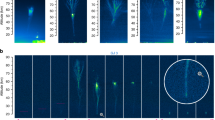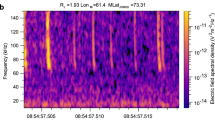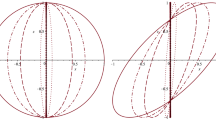Abstract
ENDURING meteor trains that appear at a height of about 85 km as double lines of light have been reported for more than a century, the first record being Newton's1 in 1869. Although the dual appearance, which has been seen in the telescope within a few seconds of train formation and by the naked eye after about 1 min, is not due to the occurrence of separate trains2, no explanation has yet been offered for the phenomenon. The peculiar formation almost certainly results from the expanding meteor train assuming the shape of a hollow cylinder3 and it is shown here that this behaviour is to be expected on the basis of recent4,5 models of the mechanism of long enduring train luminosity.
This is a preview of subscription content, access via your institution
Access options
Subscribe to this journal
Receive 51 print issues and online access
$199.00 per year
only $3.90 per issue
Buy this article
- Purchase on Springer Link
- Instant access to full article PDF
Prices may be subject to local taxes which are calculated during checkout
Similar content being viewed by others
References
Newton, H. A. Am. J. Sci. Arts 47, 399–413 (1869).
Trowbridge, C. C. Astrophys. J. 26, 95–116 (1907).
Hughes, D. W. Nature 257, 533–534 (1975).
Baggaley, W. J. Nature 257, 567–568 (1975).
Baggaley, W. J. Nature 267, 376 (1977).
Millman, P. M. in From Plasma to Planet, Nobel Symposium 21 (ed. ELvius, A.) 157–166 (Interscience, New York, 1972).
Poole, L. M. G. & Nicholson, T. F. Planet. Space Sci. 23, 1261–1277 (1975).
Brown, T. L. Chem. Rev. 73, 645–667 (1973).
Mitra, V. Ann. Geophys. 29, 341–351 (1973).
Sida, D. W. Mon. R. astr. Soc. 143, 37–47 (1969).
Verniani, F. Space Sci. Rev. 10, 230–261 (1969).
Gadsden, M. Tables of Meteor Ablation ESSA Tech. Rep. IER 42-ITSA 42 (Institute for Aeronomy, Boulder, Colorado, 1967).
Author information
Authors and Affiliations
Rights and permissions
About this article
Cite this article
BAGGALEY, W. Hollow meteor trains. Nature 270, 588–589 (1977). https://doi.org/10.1038/270588a0
Received:
Accepted:
Issue Date:
DOI: https://doi.org/10.1038/270588a0
Comments
By submitting a comment you agree to abide by our Terms and Community Guidelines. If you find something abusive or that does not comply with our terms or guidelines please flag it as inappropriate.



